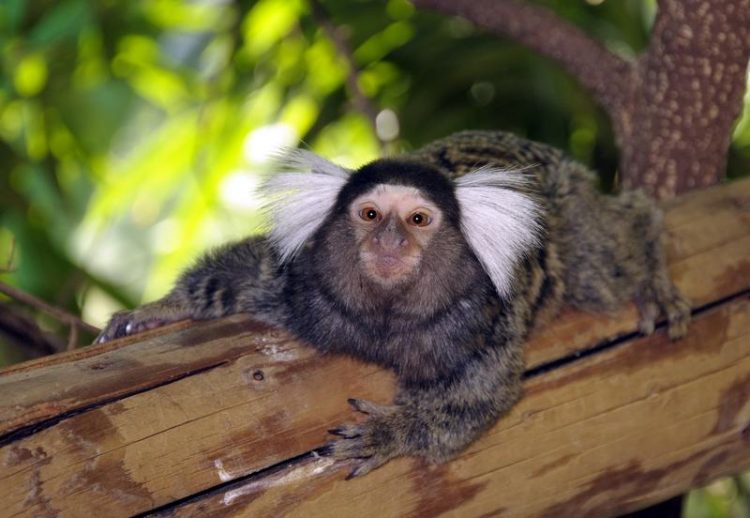Marmoset sequence sheds new light on primate biology and evolution

The common marmoset is a non-human primate that belongs to the branch of New World Monkeys. Photo: Hans Novak / Haus des Meeres
With the sequence of the marmoset, the team revealed for the first time the genome of a non-human primate in the New World monkeys, which represents a separate branch in the primate evolutionary tree that is more distant from humans than those whose genomes have been studied in detail before. The sequence allows researchers to broaden their ability to study the human genome and its history as revealed by comparison with other primates.
The biology of twinning
The study revealed unique genetic characteristics observed in the marmoset, including several genes that are likely responsible for their ability to consistently reproduce multiple births. Unlike humans, marmosets consistently give birth to twins without the association of any medical issues.
It turns out the marmoset gene WFIKKN1 exhibits changes associated with twinning in marmosets. The gene may act as a critical switch between multiples and singleton pregnancies. The finding could apply to studies of multiple pregnancies in human.
The team also looked for genetic changes associated with a unique trait found in marmosets and their close relatives, but not described in any other mammal. The dizygotic (or fraternal) twins in marmosets exchange blood stem cells called hematopoietic stem cells in utero, which leads to chimerism, a single organism composed of genetically distinct cells. The twins are full siblings, but between 10 and 50 percent of their white blood cells are actually derived from their sibling co-twin.
Marmosets also have a unique social system in which the dominant male and female serve as the primary breeders for a family, while their relatives also care for the offspring. They pick them up, carry them for long periods, and basically provide all the support allowing the breeders to reproduce again quickly. The relatives who provide the care are reproductively suppressed.
Small body size in the genes
Marmosets also have a very small body size. The genome sequence showed this may be the result of positive selection in five growth hormone/insulin-like growth factor axis genes (GH-IGF) with potential roles in producing small body size. Additionally, the team identified a cluster of genes that affect metabolic rates and body temperatures, adaptations associated with challenges of small body size.
Study provides new information on microRNAs
The study also provides new information about microRNAs, small non-coding RNA molecules which function to regulate of gene expression. “There has not been much research conducted on microRNAs in nonhuman primates, so we found this particularly important,” says Kim Worley, professor in the Human Genome Sequencing Center at Baylor College.
The team found marmosets exhibit a significant number of differences in microRNAs and their gene targets compared with humans, with two large clusters potentially involved in reproduction.
“We study primate genomes to get a better understanding of the biology of the species that are most closely related to humans,” says Jeffrey Rogers, associate professor in the Human Genome Sequencing Center at Baylor and a lead author of the report. “The previous sequences of the great apes and macaques, which are very closely related to humans on the primate evolutionary tree, have provided remarkable new information about the evolutionary origins of the human genome and the processes involved.”
The article „The Common Marmoset Genome Provides Insight into Primate Biology and Evolution“ was published on the 20th of July 2014 in the journal Nature Genetics. http://dx.doi.org/10.1038/ng.3042
About the University of Veterinary Medicine, Vienna
The University of Veterinary Medicine, Vienna in Austria is one of the leading academic and research institutions in the field of Veterinary Sciences in Europe. About 1,200 employees and 2,300 students work on the campus in the north of Vienna which also houses five university clinics and various research sites. Outside of Vienna the university operates Teaching and Research Farms. http://www.vetmeduni.ac.at
Scientific Contact:
Dr. Carolin Kosiol
Institute of Population Genetics
University of Veterinary Medicine Vienna (Vetmeduni Vienna)
T +43 1 20577-4331
M +43 6763651877
carolin.kosiol@vetmeduni.ac.at
Released by:
Susanna Kautschitsch
Science Communication / Public Relations
University of Veterinary Medicine Vienna (Vetmeduni Vienna)
T +43 1 25077-1153
susanna.kautschitsch@vetmeduni.ac.at
http://www.vetmeduni.ac.at/en/infoservice/presseinformation/press-releases-2014/…
Media Contact
All latest news from the category: Life Sciences and Chemistry
Articles and reports from the Life Sciences and chemistry area deal with applied and basic research into modern biology, chemistry and human medicine.
Valuable information can be found on a range of life sciences fields including bacteriology, biochemistry, bionics, bioinformatics, biophysics, biotechnology, genetics, geobotany, human biology, marine biology, microbiology, molecular biology, cellular biology, zoology, bioinorganic chemistry, microchemistry and environmental chemistry.
Newest articles

Properties of new materials for microchips
… can now be measured well. Reseachers of Delft University of Technology demonstrated measuring performance properties of ultrathin silicon membranes. Making ever smaller and more powerful chips requires new ultrathin…

Floating solar’s potential
… to support sustainable development by addressing climate, water, and energy goals holistically. A new study published this week in Nature Energy raises the potential for floating solar photovoltaics (FPV)…

Skyrmions move at record speeds
… a step towards the computing of the future. An international research team led by scientists from the CNRS1 has discovered that the magnetic nanobubbles2 known as skyrmions can be…





















